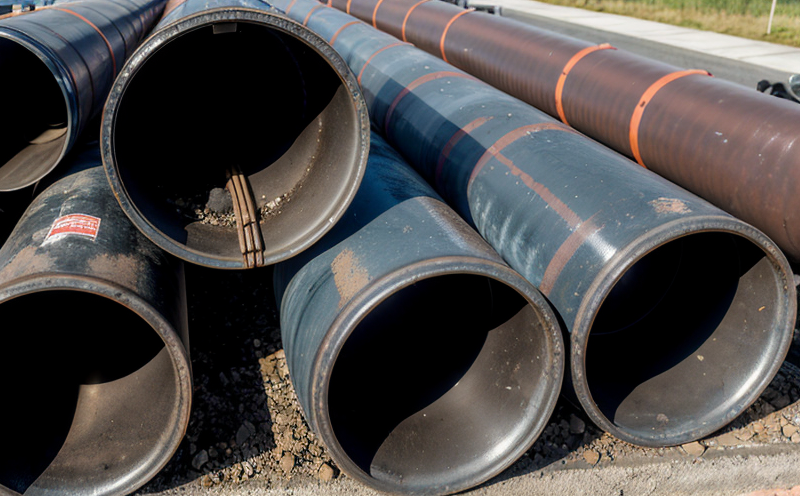ISO 4422 Pressure Testing of Plastic Water Supply Pipes
The ISO 4422 pressure testing procedure is a critical standard used in quality assurance for plastic water supply pipes. This test ensures that pipes can withstand the pressures they will encounter during installation and use, thereby guaranteeing safety and reliability in potable water distribution systems.
This service involves subjecting pipe specimens to hydrostatic pressure in accordance with ISO 4422 requirements. The aim is to verify that the pipes meet specified performance criteria under defined conditions of temperature, pressure, and duration. This testing not only ensures compliance with international standards but also enhances product reliability by identifying potential weaknesses early.
The process begins with careful preparation of the test specimens according to ISO 4422 guidelines. Specimens are typically cut from pipe sections that represent real-world applications. Following preparation, they undergo immersion in water for a specified time to ensure they have reached thermal equilibrium before testing.
Hydrostatic pressure is then applied gradually until it exceeds the design pressure of the specimen by 15%, holding this level for at least five minutes. If no leakage or other defects are observed during this period, the test passes successfully. Any failure would indicate a need for corrective measures or re-evaluation.
Compliance with ISO 4422 ensures that plastic water supply pipes meet stringent safety and performance standards set by international authorities. This enhances trust in these products within regulatory bodies and among end-users who rely on safe, reliable plumbing systems.
The benefits extend beyond mere compliance; successful passage of this test provides valuable insights into the quality and durability of materials used in manufacturing such pipes. It supports continuous improvement efforts aimed at enhancing performance across various environmental conditions while maintaining cost-effectiveness for manufacturers.
- Customer Impact and Satisfaction: By ensuring adherence to rigorous testing protocols, customers benefit from safer, more reliable plumbing systems that contribute positively towards public health and safety.
In summary, ISO 4422 pressure testing is a vital component of quality assurance processes for plastic water supply pipes. It helps maintain high standards of integrity in material selection and manufacturing techniques, ultimately leading to better performance and longevity of installed infrastructure.
Quality and Reliability Assurance
The ISO 4422 pressure testing procedure plays a crucial role in ensuring the quality and reliability of plastic water supply pipes. This test is essential for verifying that manufactured products meet specified performance criteria under defined conditions, which is particularly important given the critical nature of potable water distribution systems.
Quality assurance (QA) begins with meticulous preparation of specimens according to ISO 4422 specifications. Each step in this process—from material selection to final assembly—is aimed at producing consistent results that reflect real-world usage scenarios accurately. Once prepared, these specimens undergo rigorous hydrostatic pressure testing designed to mimic actual operating conditions.
During the test, pipes are subjected to progressively increasing pressures until they exceed their design limits by 15%. Holding this elevated pressure for five minutes allows any potential defects or weaknesses within the material composition to manifest as leaks or other signs of failure. Passing this stringent examination demonstrates not only compliance with industry standards but also enhanced confidence in product reliability.
Rejection rates directly correlate with adherence to these testing procedures, highlighting their importance in maintaining high-quality manufacturing practices. By implementing ISO 4422 pressure testing into production lines, manufacturers can identify issues early on and implement corrective actions promptly before mass production begins.
This commitment to QA contributes significantly to overall customer satisfaction by delivering products that perform reliably over extended periods without compromising safety or efficiency. Ultimately, it fosters trust between suppliers and buyers while promoting sustainable development practices within the industry.
Customer Impact and Satisfaction
- Safety: Ensures that water supply pipes can withstand the pressures they will encounter, thus protecting public health.
- Reliability: Provides assurance that plumbing systems will function correctly under expected conditions, enhancing user confidence.
- Cost-effectiveness: Identifies potential problems early in the production process, reducing costs associated with rework or recall.
- Environmental Impact: By promoting the use of durable materials and efficient manufacturing methods, this testing contributes to sustainable practices.
The ISO 4422 pressure test is instrumental in achieving these benefits. It not only guarantees compliance with international standards but also ensures that products perform reliably under various environmental conditions. This reliability translates into safer homes and buildings, which ultimately leads to greater customer satisfaction and loyalty.
Environmental and Sustainability Contributions
The implementation of ISO 4422 pressure testing in plastic water supply pipe manufacturing contributes significantly to environmental sustainability. By ensuring that pipes are durable, efficient, and resistant to leakage, this standard helps minimize resource consumption throughout the lifecycle of the product.
Through rigorous quality control measures, manufacturers can reduce waste by identifying defective materials early on during production processes. This reduces not only material wastage but also energy expenditure required for reprocessing or disposal activities later in the lifecycle.
In addition to reducing direct impacts like landfill volume and greenhouse gas emissions from manufacturing plants, ISO 4422 compliance supports broader sustainability goals through its emphasis on long-term durability. Longer-lasting pipes mean fewer replacements over time, which further reduces raw material demand and associated environmental footprints.
Furthermore, by promoting the use of sustainable materials and efficient production techniques, this testing aligns with global initiatives aimed at reducing overall carbon footprints across industries. It encourages responsible resource management practices that benefit both current generations and future ones.
The ISO 4422 pressure test thus serves as an essential tool in advancing environmental sustainability within the plumbing industry. Its focus on durability and efficiency supports broader goals of minimizing waste, conserving resources, and reducing carbon emissions throughout product lifecycles.





